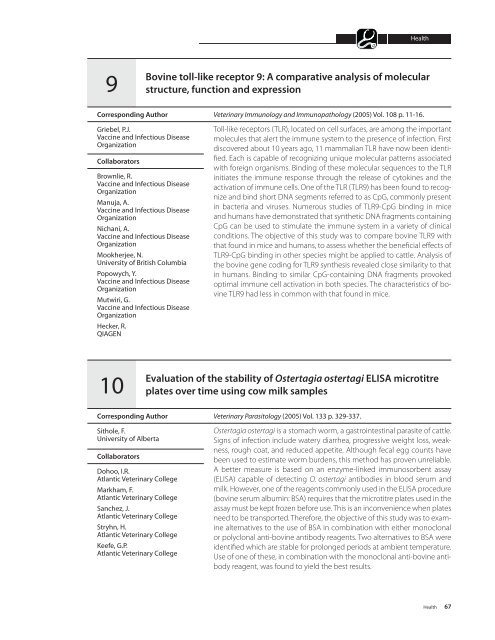Health7Specificity dependence between serological tests for diagnosingbovine brucellosis in Brucella-free farms showing false positiveserological reactions due to Yersinia enterocolitica O:9Corresponding AuthorMainar-Jaime, R.C.Western College of VeterinaryMedicineCollaboratorsMunoz, P.M.Centro de Investigacion yTecnologia Agroalimentariade Miguel, M.J.Centro de Investigacion yTecnologia AgroalimentariaGrillo, M.J.Centro de Investigacion yTecnologia AgroalimentariaMarin, C.M.Centro de Investigacion yTecnologia AgroalimentariaMoriyon, I.Universidad de NavarraBlasco, J.M.Centro de Investigacion yTecnologia AgroalimentariaCanadian Veterinary Journal (2005) Vol. 46 p. 913-916.Brucellosis is a disease with worldwide distribution affecting humans andmany animal species, both domestic and wild. Caused by bacteria of thegenus Brucella, the disease in female cattle is characterized by abortion,stillborn or weak calves, retained placentas, and reduced milk yield. Eradicationof brucellosis is based on culling animals that have positive bloodtests for antibodies to Brucella species. Although several tests can be used,some can yield false positive results. Therefore, to minimize the chance ofculling animals giving false positive test results, the use of at least 2 independenttests is usually recommended. However, the choice of tests to useis critical. If the specificity of one test is independent of the other, then thecombined specificity of the 2 tests should be higher than either alone. Ifthe specificities of the 2 tests are not independent, then their combinedspecificity will be lower than expected. This study demonstrates that thelatter is the case for the currently most widely used test combination—therose bengal and complement fixation tests. Use of that test combinationyielded false positives in Brucellosis-free herds infected with Yersinia enterocoliticaO:9. The authors suggest that the indirect enzyme-linked immunosorbentassay (iELISA) for Brucella antibodies, used alone, might bea better choice.8Amended recombinant cells (ARCsTM): An economical andsurprisingly effective production and delivery vehicle forrecombinant bovine IFN-γCorresponding AuthorGriebel, P.J.Vaccine and Infectious DiseaseOrganizationCollaboratorsGaertner, F.H.ConsultantBabiuk, L.A.Vaccine and Infectious DiseaseOrganizationVan Moorlehem, E.A.Vaccine and Infectious DiseaseOrganizationBeskorwayne, T.K.Vaccine and Infectious DiseaseOrganizationLee, S.L.The Dow Chemical CompanyShutter, R.W.The Dow Chemical CompanyArmstrong, J.M.Dow AgroSciencesJournal of Controlled Release (2005) Vol. 107 p. 189-202.Interferon-gamma (IFN-γ) is one of a number of biochemicals called cytokineswhich play important roles in initiating and controlling the immuneresponse. Although initially recognized for its antiviral activity, IFN-γ is nowknown to regulate the synthesis of a large number of important immunesystem proteins. These activities created interest in the therapeutic potentialof IFN-γ. Once the genetic code for IFN-γ was identified, it was possibleto splice this code segment into the bacterial genome to manufacture recombinantIFN-γ (rIFN-γ). The therapeutic potential of purified rIFN-γ wassubsequently tested in a number of human and cattle trials. Although severalof these trials demonstrated that rIFN-γ could enhance the immuneresponse, its routine use was hampered by its high cost and rapid breakdown.A number of approaches to achieving sustained release preparationsof rIFN-γ have been attempted. The most successful have been thosewhere the cytokine was delivered in live bacterial cells. However, administrationof live organisms raises concerns about patient safety and it is difficultto assure consistent delivery. This paper describes a novel methodfor the production of rIFN-γ by recombinant Pseudomonas fluorescens cellswhich are subsequently treated to sterilize the bacteria and ‘amend’ theircell walls. These amended, recombinant cells (ARCs) can be produced atlow cost and have high immunostimulatory activity with little risk of sideeffects.66 Highlights in Canadian Dairy Cattle Research - 2007
Health9Bovine toll-like receptor 9: A comparative analysis of molecularstructure, function and expressionCorresponding AuthorGriebel, P.J.Vaccine and Infectious DiseaseOrganizationCollaboratorsBrownlie, R.Vaccine and Infectious DiseaseOrganizationManuja, A.Vaccine and Infectious DiseaseOrganizationNichani, A.Vaccine and Infectious DiseaseOrganizationMookherjee, N.University of British ColumbiaPopowych, Y.Vaccine and Infectious DiseaseOrganizationMutwiri, G.Vaccine and Infectious DiseaseOrganizationHecker, R.QIAGENVeterinary Immunology and Immunopathology (2005) Vol. 108 p. 11-16.Toll-like receptors (TLR), located on cell surfaces, are among the importantmolecules that alert the immune system to the presence of infection. Firstdiscovered about 10 years ago, 11 mammalian TLR have now been identified.Each is capable of recognizing unique molecular patterns associatedwith foreign organisms. Binding of these molecular sequences to the TLRinitiates the immune response through the release of cytokines and theactivation of immune cells. One of the TLR (TLR9) has been found to recognizeand bind short DNA segments referred to as CpG, commonly presentin bacteria and viruses. Numerous studies of TLR9-CpG binding in miceand humans have demonstrated that synthetic DNA fragments containingCpG can be used to stimulate the immune system in a variety of clinicalconditions. The objective of this study was to compare bovine TLR9 withthat found in mice and humans, to assess whether the beneficial effects ofTLR9-CpG binding in other species might be applied to cattle. Analysis ofthe bovine gene coding for TLR9 synthesis revealed close similarity to thatin humans. Binding to similar CpG-containing DNA fragments provokedoptimal immune cell activation in both species. The characteristics of bovineTLR9 had less in common with that found in mice.10Evaluation of the stability of Ostertagia ostertagi ELISA microtitreplates over time using cow milk samplesCorresponding AuthorSithole, F.University of AlbertaCollaboratorsDohoo, I.R.Atlantic Veterinary CollegeMarkham, F.Atlantic Veterinary CollegeSanchez, J.Atlantic Veterinary CollegeStryhn, H.Atlantic Veterinary CollegeKeefe, G.P.Atlantic Veterinary CollegeVeterinary Parasitology (2005) Vol. 133 p. 329-337.Ostertagia ostertagi is a stomach worm, a gastrointestinal parasite of cattle.Signs of infection include watery diarrhea, progressive weight loss, weakness,rough coat, and reduced appetite. Although fecal egg counts havebeen used to estimate worm burdens, this method has proven unreliable.A better measure is based on an enzyme-linked immunosorbent assay(ELISA) capable of detecting O. ostertagi antibodies in blood serum andmilk. However, one of the reagents commonly used in the ELISA procedure(bovine serum albumin: BSA) requires that the microtitre plates used in theassay must be kept frozen before use. This is an inconvenience when platesneed to be transported. Therefore, the objective of this study was to examinealternatives to the use of BSA in combination with either monoclonalor polyclonal anti-bovine antibody reagents. Two alternatives to BSA wereidentified which are stable for prolonged periods at ambient temperature.Use of one of these, in combination with the monoclonal anti-bovine antibodyreagent, was found to yield the best results.Health 67





